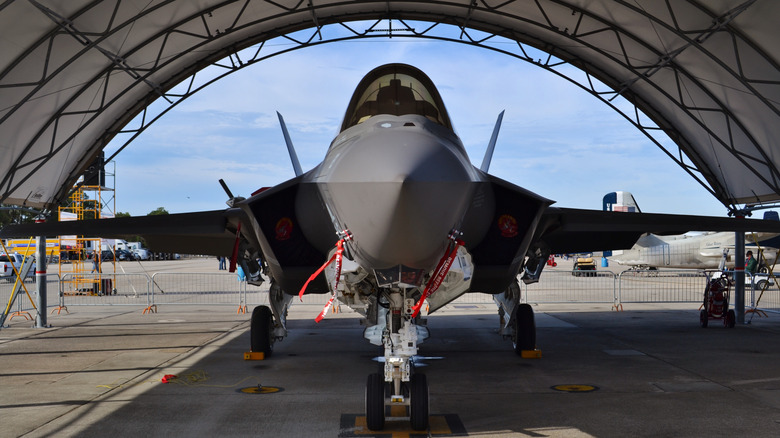During this year’s Sea Air Space (SAS) 2024 defense expo, Lockheed Martin (in partnership with CoAspire) unveiled a never-before-seen model of a hypersonic missile system. Dubbed «Mako,» after the fastest-swimming shark species at sea, the missile was initially conceived for the Air Force’s Stand-in Attack Weapon (SiAW) program, but was later rejected.
Lockheed is now presenting the missile as a promising hypersonic strike option not just for the F-35 Lightning II, but also for other platforms, including naval strike fighters and surface combatants. The Mako marks the debut of the first-ever hypersonic missile system compatible with the F-35.
While details about the missile remain scarce, Rob Osterhoudt — a senior manager at Lockheed — provided insights in an interview with The War Zone. The missile is powered by a solid-fuel motor and boasts an intriguing «13-themed» specifications: 13 feet long, 13 inches in diameter, weighing 13,000 pounds, with a 130-pound warhead. Additionally, Lockheed disclosed in an email to AirPower podcast host Alex Hollings that the Mako operates as a «true hypersonic weapon» rather than having an «arcing ballistic flight path» of a hypersonic glide vehicle (HGV), setting it apart from the U.S AGM-183A Air-Launched Rapid Response Weapon (ALRRW) or the Russian Avangard.
Despite its lighter weight and smaller payload, the Mako compensates with its speed, which can help the U.S air assets penetrate dense anti-air umbrella from a safe stand-off range. Compatible with strike fighters, the Mako also promises rapid reaction time — one of the key benefits of hypersonic-class weapons.
What the Mako is designed for
The Mako was Lockheed’s bid for the nearly seven-year-old SiAW program. Per a Research, Development, Test, and Evaluation (RDTE) report, the program aims to «provide strike capability to defeat rapidly relocatable targets that create the Anti-Access/Area Denial (A2/AD) environment.» The report also went into extra detail, including how SiAW’s primary targets are «theater ballistic missile launchers, land attack and anti-ship cruise missile launchers, GPS jammers, anti-satellite systems, and integrated air defense systems.» The finishing product is to be integrated with the Air Force-specific F-35A.
In 2023, however, the Air Force selected Northrop Grumman’s bid over Lockheed’s. Northrop’s candidate is an evolution of the AGM-88G Advanced Anti-Radiation Guided Missile Extended Range (AARGM-ER), which has roughly the same Suppression of Enemy’s Air Defense (SEADS)-centric mission profile as the SiAW, while also having the advantage of being a proven design.
Despite being washed out of the SiAW program, Lockheed isn’t shelving the Mako. According to Osterhoudt, the program has matured with a high Technology Readiness Level (TRL). As a result, Lockheed is going public to «find a customer who’s willing to support us, building the missile, and actually demonstrating in flight.»
Besides the Navy, it’s currently unknown who Lockheed is approaching as customers, or whether the Pentagon is willing to export hypersonic-capable weapons. However, with the F-35 already being (or will be) in service with 13 partner nations, the pool of potential customers is large.
Lockheed is looking beyond the F-35 for the Mako

Michael Fitzsimmons/Getty Images
While the F-35 is the «threshold platform» for the SiAW program (and, as a result, a design requirement for the Mako), it’s not the Mako’s only carriage. The missile, according to Naval News, can be integrated into any aircraft that uses a bomb rack with a 30-inch lug size. The list of such aircraft is long, from every variant of the F-35, the Navy’s F-18 family of carrier strike aircraft (both Super Hornets and Growlers alike), to the Air Force’s F-22 Raptors and F-16 Fighting Falcon. Remarkably, the Mako has even been fitted to a Navy’s P-8A Poseidon — a maritime patrol aircraft.
Why the P-8A? Beyond its land strike role, the Mako can also function as an anti-surface ship missile. While it’s not positioned to directly compete with the Navy’s high-end Hypersonic Air-Launched Offensive Anti-Surface Warfare (HALO) missile, Lockheed envisions the Mako as a cross-domain weapon capable of engaging both sea and land targets simultaneously.
This scenario introduces an intriguing dynamic where naval air assets, such as the P-8A Poseidon, equipped with the Mako, can seamlessly transition into land attack roles when needed. This operational flexibility is a core part of Lockheed’s pitch to the Navy, especially following its inability to meet the Air Force’s requirements. It’s where CoAspire — the co-host alongside Lockheed at the Mako’s booth at SAS 2024 — comes in: To aid with the research and potential integration of the Mako onto naval assets.
Navalized variant of the Mako in the works
Osterhoudt, in discussing Lockheed’s collaboration with CoAspire, also highlighted their exploration of integrating Makos into the Vertical Launching System (VLS) for submarines or surface ships. VLS-equipped naval vessels, most notably the Arleigh Burke-class destroyers, and Los Angeles-class attack submarines have cells pre-loaded with ready-to-fire missiles.
By making the Mako VLS-capable, Lockheed presents a compelling proposition to the Navy: A fast and cost-effective means to rapidly equip U.S. naval assets with hypersonic strike capabilities. Consequently, the Navy is considering the Mako proposal under the umbrella of an Other Transaction Authority (OTA), which has a significantly expedited R&D, prototyping, and production process compared to standard defense contracts.
However, Northrop Grumman’s winning SiAW design — born from the same cradle as the Mako — might possess most, if not all, of the capabilities presented by Lockheed. While there are no known plans for a navalized variant of SiAW, Northrop is developing a containerized version of the AARGM-ER known as the Modular Payload System (MPS). Given its shared heritage with the AARGM-ER, SiAW could potentially be containerized as well, and then be adapted for shipboard use.
As Northrop’s SiAW is already in the procurement pipeline, it’ll be intriguing to see how Lockheed aims to differentiate the Mako. The leading theory revolves around affordability: Powered by a solid-fuel rocket motor rather than complex scramjets, the Mako could hold a cost advantage over other hypersonic options.